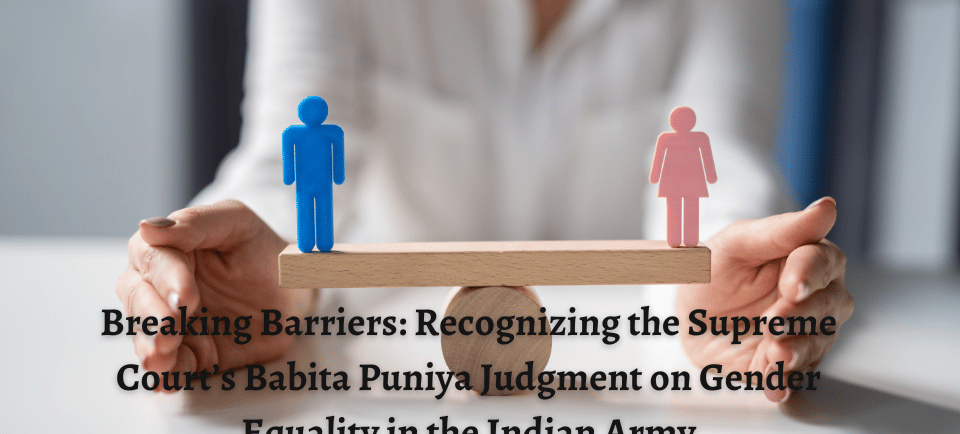Breaking Barriers: Recognizing the Supreme Court’s Babita Puniya Judgment on Gender Equality in the Indian Army


Four years ago, the Supreme Court of India delivered a landmark judgment in Secretary, Ministry of Defence v. Babita Puniya & Ors., advancing gender equality in the Indian Armed Forces. This ruling granted women officers eligibility for Permanent Commissions (PCs) on equal terms with male counterparts, effectively challenging long-standing stereotypes and discriminatory practices. It was a monumental stride towards a more egalitarian society and underscored the judiciary's commitment to upholding constitutional values. Today, reflecting on this decision allows us to appreciate how the Court had taken a proactive stance to correct institutional biases that had restricted women’s roles within the military.
Background of the Case
Historically, women in the Indian Army had been recruited in non-combat roles through Short Service Commissions (SSCs) with limited tenure, while male officers had been eligible for PCs, providing them with career stability and associated benefits. Consequently, female officers in SSC positions had been excluded from the same opportunities, prompting a series of legal challenges starting in 2003 and 2006. Women officers and advocates had sought parity through these petitions, pushing for an end to gender-based restrictions on PCs. In 2010, the Delhi High Court ruled in favor of these petitioners, instructing the Ministry of Defence to treat women SSC officers on par with men regarding eligibility for PCs. The Ministry challenged this decision, and the case ultimately reached the Supreme Court.
Analyzing the Supreme Court’s Ruling
The Supreme Court’s 2020 judgment was notable for its clarity, depth, and commitment to principles of equality. By upholding the Delhi High Court's decision, the Supreme Court affirmed that gender could not be a basis for denying equal opportunities within the Armed Forces. The Court’s analysis revealed that the government’s arguments for excluding women from PCs—such as concerns over physical standards, unit cohesion, and logistical limitations in remote postings—were based on outdated gender stereotypes rather than evidence-based needs. The Court’s ruling emphasized that such regressive assumptions about women’s roles and capabilities could not justify discrimination in an era of constitutional rights and equality.
Key Points from the Ruling
1. Principle of Non-Discrimination: Invoking Articles 15(1) and 16(1) of the Constitution, which guarantee equality and prohibit discrimination based on gender, the Court declared that denying PCs to women officers violated fundamental rights. It found that such a policy lacked rational basis and failed to hold up under constitutional scrutiny.
2. Constitutional Mandate of Equality: The Court rejected arguments about “physiological differences” and “operational challenges” as a rationale for exclusion, underscoring that equality of opportunity is a constitutional mandate. This decision underscored that policies and practices in the Armed Forces must reflect a commitment to equality, ensuring that women had the same rights to advance their careers as men.
3. Stereotypes and Gender Bias: The Court critically addressed the Ministry of Defence's reliance on gender stereotypes. Statements from the Ministry about women’s familial obligations or perceived limitations in military roles were called out as "constitutionally flawed." The Court noted that such assumptions only reinforced gender biases, rather than allowing a fair assessment of individual merit.
4. Recognition of Women’s Contributions: In its ruling, the Court acknowledged and celebrated the commendable service and contributions of women officers. By highlighting instances where women officers had excelled nationally and internationally, the Court affirmed that competence and dedication transcended gender.
5. Implementation of Permanent Commissions: The Court’s judgment mandated that women SSC officers should be considered for PCs in all the streams where they had been inducted, with only combat roles remaining excluded as a matter of policy. Women officers who met PC eligibility criteria were entitled to the same promotion, pension, and career progression opportunities as their male colleagues.
A Step Forward for Gender Equality
This judgment represented a milestone for gender equality in India, as it addressed institutionalized biases and underscored that gender should not limit opportunities in any profession, including the Armed Forces. The ruling also aligned with global trends recognizing the rights of women to serve on equal terms in the military, challenging historical prejudices that had hindered their full participation.
The Supreme Court’s ruling resonated with broader societal shifts towards gender equality. This case illustrated how the judiciary can play a transformative role in advancing institutional reform, encouraging the Armed Forces and other institutions to embrace inclusivity and diversity.
Challenges and Future Implications
While this judgment had set a powerful precedent, practical challenges remained. The Armed Forces, a traditionally male-dominated institution, needed to ensure that its policies and practices aligned with the Court’s mandate. This likely involved adjustments in training, infrastructure, and culture to support the integration of women into roles previously limited to men. Nevertheless, the judgment provided a clear directive for modernization and reform, affirming that the Armed Forces had to evolve in line with constitutional values of equality.
Conclusion
The Supreme Court’s 2020 judgment in Secretary, Ministry of Defence v. Babita Puniya & Ors. stands as a lasting affirmation of India’s commitment to equality under the Constitution. By removing gender-based barriers to Permanent Commissions, the Court ensured that women in the Armed Forces received not only professional parity but also the respect and dignity they deserve as equal citizens. This ruling challenged regressive practices and encouraged the Armed Forces to better reflect the diversity and resilience of modern India. In implementing this mandate, the Armed Forces would continue to uphold a vision of India where gender does not determine opportunity — and where equality is honored not just in words, but in practice.